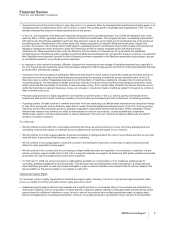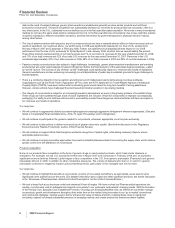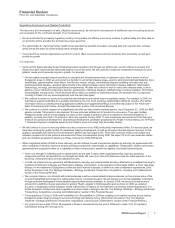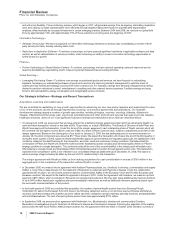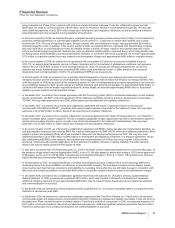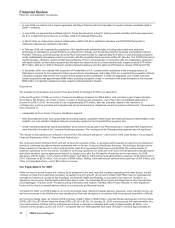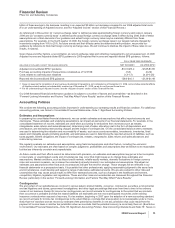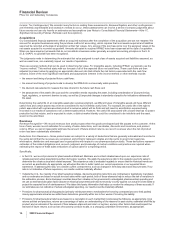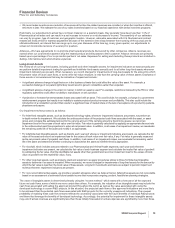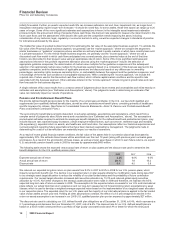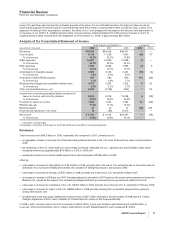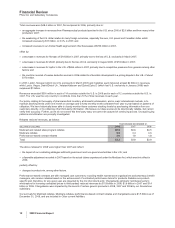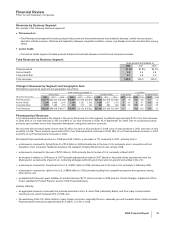Pfizer 2008 Annual Report Download - page 17
Download and view the complete annual report
Please find page 17 of the 2008 Pfizer annual report below. You can navigate through the pages in the report by either clicking on the pages listed below, or by using the keyword search tool below to find specific information within the annual report.
Financial Review
Pfizer Inc and Subsidiary Companies
•We record sales incentives as a reduction of revenues at the time the related revenues are recorded or when the incentive is offered,
whichever is later. We estimate the cost of our sales incentives based on our historical experience with similar incentives programs.
Historically, our adjustments to actual have not been material; on a quarterly basis, they generally have been less than 1.0% of
Pharmaceutical net sales and can result in a net increase to income or a net decrease to income. The sensitivity of our estimates
can vary by program, type of customer and geographic location. However, estimates associated with U.S. Medicaid and contract
rebates are most at-risk for material adjustment because of the extensive time delay between the recording of the accrual and its
ultimate settlement, an interval that can range up to one year. Because of this time lag, in any given quarter, our adjustments to
actual can incorporate revisions of several prior quarters.
Alliances—We have agreements to co-promote pharmaceutical products discovered by other companies. Alliance revenues are
earned when our co-promotion partners ship the related product and title passes to their customer. Alliance revenues are primarily
based upon a percentage of our co-promotion partners’ net sales. Expenses for selling and marketing these products are included in
Selling, informational and administrative expenses.
Long-Lived Assets
We review all of our long-lived assets, including goodwill and other intangible assets, for impairment indicators at least annually and
we perform detailed impairment testing for goodwill and indefinite-lived assets annually and for all other long-lived assets whenever
impairment indicators are present. When necessary, we record charges for impairments of long-lived assets for the amount by which
the present value of future cash flows, or some other fair value measure, is less than the carrying value of these assets. Examples of
those events or circumstances that may be indicative of impairment include:
•A significant adverse change in legal factors or in the business climate that could affect the value of the asset. For example, a
successful challenge of our patent rights likely would result in generic competition earlier than expected.
•A significant adverse change in the extent or manner in which an asset is used. For example, restrictions imposed by the FDA or other
regulatory authorities could affect our ability to manufacture or sell a product.
•A projection or forecast that demonstrates losses associated with an asset. This could include, for example, a change in a government
reimbursement program that results in an inability to sustain projected product revenues and profitability. This also could include the
introduction of a competitor’s product that results in a significant loss of market share or the lack of acceptance of a product by patients,
physicians and payers.
Our impairment review process is as follows:
•For finite-lived intangible assets, such as developed technology rights, whenever impairment indicators are present, we perform an
in-depth review for impairment. We calculate the undiscounted value of the projected cash flows associated with the asset, or asset
group, and compare this estimated amount to the carrying amount. If the carrying amount is found to be greater, we record an
impairment loss for the excess of book value over fair value. Fair value is generally calculated by applying an appropriate discount rate
to the undiscounted cash flow projections to arrive at net present value. In addition, in all cases of an impairment review, we reevaluate
the remaining useful life of the asset and modify it, as appropriate.
•For indefinite-lived intangible assets, such as brands, each year and whenever impairment indicators are present, we calculate the fair
value of the asset and record an impairment loss for the excess of book value over fair value, if any. Fair value is generally measured
as the net present value of projected cash flows. In addition, in all cases of an impairment review, we reevaluate the remaining useful
life of the asset and determine whether continuing to characterize the asset as indefinite-lived is appropriate.
•For Goodwill, which includes amounts related to our Pharmaceutical and Animal Health segments, each year and whenever
impairment indicators are present, we calculate the fair value of each business segment and calculate the implied fair value of goodwill
by subtracting the fair value of all the identifiable net assets other than goodwill and record an impairment loss for the excess of book
value of goodwill over the implied fair value, if any.
•For other long-lived assets, such as property, plant and equipment, we apply procedures similar to those for finite-lived intangible
assets to determine if an asset is impaired. When necessary, we record charges for impairments of long-lived assets for the amount by
which the fair value is less than the book value of these assets. Long-term investments and loans are subject to periodic impairment
reviews whenever impairment indicators are present.
•For non-current deferred tax assets, we provide a valuation allowance when we believe that our deferred tax assets are not recoverable
based on an assessment of estimated future taxable income that incorporates ongoing, prudent, feasible tax-planning strategies.
The value of intangible assets is determined primarily using the “income method,” which starts with a forecast of all the expected
future net cash flows, some of which are more certain than others. For example, the valuation of an intangible asset may include the
cash flows associated with selling the approved product throughout the world, as well as the value associated with using the
developed technology in current R&D projects. In this situation, the projected cash flows of the approved indications are more likely
to be achieved than the potential cash flows associated with R&D projects for the currently unapproved indications. The unequal
probability of realizing these cash flow streams reflects the uncertainty associated with the future benefits of individual R&D projects
and those that leverage the benefits of developed technology. Accordingly, the potential for impairment for these intangible assets
may exist if actual revenues are significantly less than those initially forecasted or actual expenses are significantly more than those
2008 Financial Report 15


